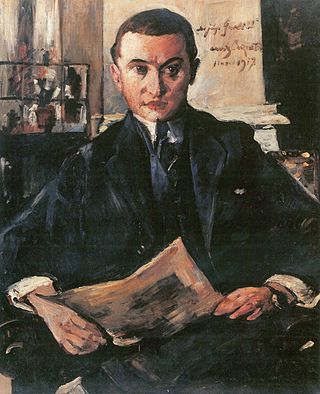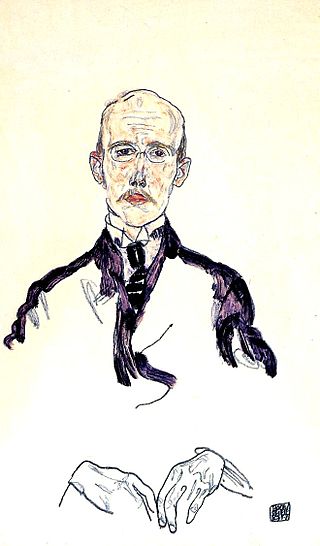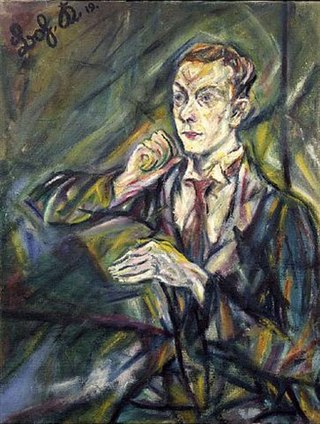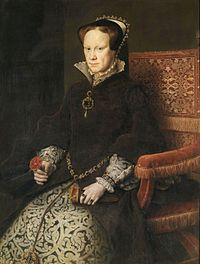
Egon Leo Adolf Ludwig Schiele was an Austrian Expressionist painter. His work is noted for its intensity and its raw sexuality, and for the many self-portraits the artist produced, including nude self-portraits. The twisted body shapes and the expressive line that characterize Schiele's paintings and drawings mark the artist as an early exponent of Expressionism. Gustav Klimt, a figurative painter of the early 20th century, was a mentor to Schiele.

The Österreichische Galerie Belvedere is a museum housed in the Belvedere palace, in Vienna, Austria.

The Leopold Museum, housed in the Museumsquartier in Vienna, Austria, is home to one of the largest collections of modern Austrian art, featuring artists such as Egon Schiele, Gustav Klimt, Oskar Kokoschka, and Richard Gerstl.

The Lentos Art Museum is a museum of modern art in Linz, Austria, which opened in May 2003 as the successor to the Neue Galerie der Stadt Linz.

Wolfgang Gurlitt was a German art dealer, museum director and publisher whose art collection included Nazi-looted art.
Rudolf Leopold was an Austrian art collector, whose collection of 5,000 works of art was purchased by the Government of Austria and used to create the Leopold Museum, of which he was made director for life. Claims had been made by Jewish survivors of the Holocaust that some of the pieces in the collection were Nazi plunder and should be returned to their rightful owners.

Portrait of Wally is a 1912 oil painting by Austrian painter Egon Schiele of Walburga "Wally" Neuzil, a woman whom he met in 1911 when he was 21 and she was 17. She became his lover and model for several years, depicted in a number of Schiele's most striking paintings. The painting was obtained by Rudolf Leopold in 1954 and became part of the collection of the Leopold Museum when it was established by the Austrian government, purchasing 5,000 pieces that Leopold had owned. Near the end of a 1997–1998 exhibit of Schiele's work at the Museum of Modern Art in New York, the painting's ownership (provenance) history was revealed in an article published in The New York Times. After the publication, the heirs of Lea Bondi Jaray, to whom the work had belonged before World War II, contacted the New York County District Attorney who issued a subpoena forbidding its return to Austria. The work was tied up in litigation for years by Bondi's heirs, who claimed that the painting was Nazi plunder and should have been returned to them.

Serena (Szeréna) Pulitzer Lederer was an Austro-Hungarian art collector and the spouse of the industrial magnate August Lederer, close friend of Gustav Klimt and instrumental in the constitution of the collection of Klimt's art pieces.
Eberhard W. Kornfeld was a Swiss auctioneer, author, art dealer, and collector based in Bern.

Karl Mayländer was an Austrian art collector and businessman who was deported in 1941 from Vienna to Łódź, in German-occupied Poland, by the Nazis and later murdered in the Shoah.
Jane Kallir is an American art dealer, curator and author. She is co-director of the Galerie St. Etienne in New York, which specializes in Austrian and German Expressionism as well as self-taught and “outsider” art. In 2020, the gallery ceased commercial operations and became an art advisory. Its archives and library were transferred to the Kallir Research Institute, a foundation established in 2017. Kallir serves as President of the KRI. She has curated exhibitions for many American and international museums and is the author of the catalogue raisonné of Egon Schiele’s work in all mediums.
Galerie St. Etienne is a New York art gallery specializing in Austrian and German Expressionism, established in Vienna in 1939 by Otto Kallir. In 1923, Kallir founded the Neue Galerie in Vienna. Forced to leave Austria after the 1938 Nazi invasion, Kallir established his gallery in Paris as the Galerie St. Etienne, named after the Neue Galerie's location near Vienna's Cathedral of St. Stephen. In 1939, Kallir and his family left France for the United States, moving the Galerie St. Etienne to New York City. The gallery still exists, run by Otto Kallir's granddaughter Jane at 24 West 57th Street.

Otto Kallir was an Austrian-American art historian, author, publisher, and gallerist. He was awarded the Silbernes Ehrenzeichen für Verdienste um das Land Wien in 1968.

August Lederer, was an Austrian industrialist and art collector whose art collection was looted by Nazis. He helped promote the artists of the Vienna Secession, notably Gustav Klimt.

Dead City III is an oil on wood expressionist painting by Egon Schiele from 1911. It was owned by the Viennese cabaret artist Fritz Grünbaum before he was murdered by Nazis and has been the object of high-profile disputes and court battles. Suspected by New York's District Attorney of having been looted by the Nazis, Dead City III was temporarily confiscated from the Austrian art collector Rudolf Leopold after he loaned it to a New York museum in 1998. The ownership history of the painting has been the object of high-profile court cases in which two very different versions of the painting's journey from the Jewish Holocaust victim to the Austrian art collector collide.
Serge Sabarsky was an art collector and art dealer of the 20th century.

Walburga "Wally" Neuzil was an Austrian nurse who was the lover and muse of the artist Egon Schiele between 1911 and 1915.
Franz Kieslinger was an Austrian art historian and art dealer, who was a Nazi and involved in art theft during the Nazi era.
Friedrich Maximilian Welz was an Austrian art dealer and Nazi Party member investigated for art looting.

Jenny Steiner was an Austro-Hungarian art collector, patron of the arts and factory owner expropriated under the Nazis.












